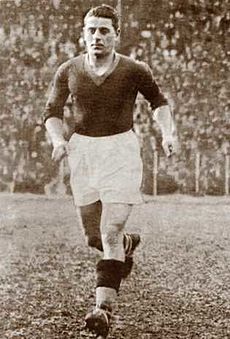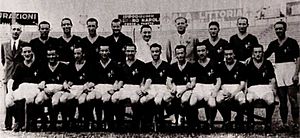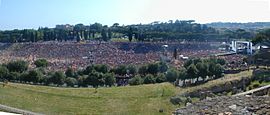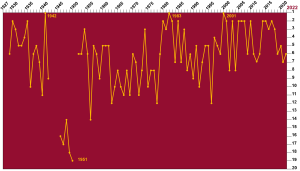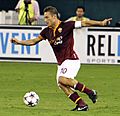AS Roma facts for kids
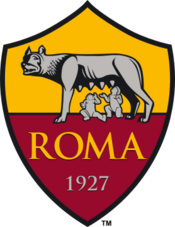 |
||
| Full name | Associazione Sportiva Roma S.p.A. | |
|---|---|---|
| Nickname(s) | I Giallorossi (The Yellow and Reds) I Lupi (The Wolves) La Magica (The Magic One) |
|
| Founded | 7 June 1927 (as Italo Foschi) | |
| Ground | Stadio Olimpico | |
| Capacity | 70,634 | |
| Owner | The Friedkin Group (95.97%) | |
| President | Dan Friedkin | |
| Head coach | Gian Piero Gasperini | |
| League | Serie A | |
| 2018–19 | Serie A, 6th of 20 | |
|
|
||
Associazione Sportiva Roma, often called AS Roma or simply Roma, is a professional football club from Rome, Italy. It was formed in 1927 when three older clubs merged. Roma has almost always played in Italy's top football league, Serie A, missing only one season in 1951–52.
The club has won the Serie A title three times: in 1941–42, 1982–83, and 2000–01. They have also won the Coppa Italia nine times and the Supercoppa Italiana twice. In European competitions, Roma won the Inter-Cities Fairs Cup in 1960–61 and the UEFA Conference League in 2021–22. They were also runners-up in the 1983–84 European Cup, the 1990–91 UEFA Cup, and the 2022–23 UEFA Europa League.
Many famous players have won the FIFA World Cup while playing for Roma. These include Bruno Conti (1982), Aldair (1994), Cafu (2002), and Daniele De Rossi, Simone Perrotta, and Francesco Totti (2006). Most recently, Paulo Dybala won it in 2022.
Since 1953, Roma has played its home games at the Stadio Olimpico. They share this stadium with their city rivals, Lazio. The Stadio Olimpico can hold over 70,000 fans, making it the second-largest stadium in Italy. Roma and Lazio have a strong local rivalry, and their matches are known as the Derby della Capitale.
Roma's home colours are carmine red and golden yellow, which is why they are nicknamed "I Giallorossi" (The Yellow and Reds). The club's badge features a she-wolf, which is a symbol from the ancient myth of Rome's founding.
Contents
- Club History: A Journey Through Time
- Club Identity: Colors, Nicknames, and Symbols
- Stadiums and Training Ground
- Roma Supporters and Rivalries
- Players and Management
- Club Leaders: Chairmen History
- Coaches Through the Years
- Club Achievements and Trophies
- Hall of Fame: Honoring Club Legends
- Club Records and Statistics
- Images for kids
- See also
Club History: A Journey Through Time
How AS Roma Started
AS Roma was created in 1927. It happened when three older football clubs in Rome – Roman FC, SS Alba-Audace, and Fortitudo-Pro Roma SGS – joined together. This merger was started by Italo Foschi, a key figure in the ruling National Fascist Party.
The main goal was to create one strong club in the Italian capital. This new club would be able to compete with the powerful teams from Northern Italy. Only Lazio did not join the merger. Even though the three founding clubs had been relegated, the new AS Roma team was given a special chance to play in the top league, the Divisione Nazionale.
Roma first played at the Motovelodromo Appio stadium. Then, they moved to a wooden stadium called Campo Testaccio in 1929. In the 1930–31 season, Roma finished second in the league. Players like captain Attilio Ferraris, Guido Masetti, Fulvio Bernardini, and Rodolfo Volk were very important during this time.
First Big Win and Later Challenges
After some ups and downs, Roma built a stronger team. They added great goal scorers like Enrique Guaita. In 1935–36, under manager Luigi Barbesino, Roma almost won their first title, finishing just one point behind Bologna.
Roma then achieved an amazing victory in the 1941–42 season, winning their first scudetto (league title). Local player Amedeo Amadei scored 18 goals, which was key to this win. At that time, Italy was involved in World War II.
After the war, Roma struggled to keep their top position. They finished in the lower half of Serie A for five seasons. In 1950–51, they were relegated to Serie B for the only time in their history. However, they quickly returned to Serie A the next season under manager Giuseppe Viani.
Back in Serie A, Roma became a strong team again. They had players like Egisto Pandolfini and Dino da Costa. In 1954–55, they finished as runners-up. Even though they didn't win the league, Roma found success in cup competitions. In 1960–61, they won their first international trophy, the Inter-Cities Fairs Cup, by beating Birmingham City. A few years later, in 1963–64, Roma won their first Coppa Italia trophy.
In 1964–65, the club faced financial problems. Supporters helped by raising money, and a new president, Franco Evangelisti, saved the club from bankruptcy. Roma won their second Coppa Italia in 1968–69. Giacomo Losi became a club legend, playing 450 games for Roma by 1969.
Ups and Downs from the 1970s to the 1990s

In 1972, Roma won another cup, the Anglo-Italian Cup. Throughout the 1970s, Roma's league performance was mixed. Their best finish was third place in 1974–75. Players like Giancarlo De Sisti and Francesco Rocca were important during this time.
A new successful era began with another Coppa Italia win in 1979–80. Roma then came very close to winning the league in 1980–81, finishing second to Juventus. The team was managed by Nils Liedholm and included stars like Bruno Conti, Agostino Di Bartolomei, Roberto Pruzzo, and Falcão.
Roma finally won their second scudetto in 1982–83, after 41 years. The city of Rome celebrated hugely. The next season, Roma finished second in Italy and won another Coppa Italia. They also reached the European Cup final but lost to Liverpool in a penalty shootout. Roma's successful 1980s ended with a second-place league finish in 1985–86 and another Coppa Italia win.
After this, Roma's league performance declined. One highlight was a third-place finish in 1987–88. In 1991, Roma reached the UEFA Cup final but lost to Internazionale. In the same season, they won their seventh Coppa Italia. The rest of the 1990s were not as successful for Roma in the league. However, a young striker named Francesco Totti emerged, who would become a club icon.
Third League Title in the Sensi Era
Roma won their third Serie A title in 2000–01. They secured the Scudetto on the final day of the season by beating Parma 3–1, finishing two points ahead of Juventus. Captain Francesco Totti was a huge part of this victory and became one of the club's greatest heroes. Other key players included Aldair, Cafu, Gabriel Batistuta, and Vincenzo Montella.
In the following years, Roma often finished as runners-up in both Serie A and the Coppa Italia. They were second to Juventus in 2001–02 and to Milan in 2003–04.
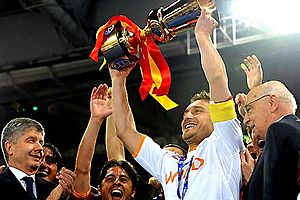
In 2006, Roma players Francesco Totti, Daniele De Rossi, and Simone Perrotta were part of the Italy team that won the FIFA World Cup. Roma was not involved in the Calciopoli scandal that year. After the scandal, Roma was re-classified as runners-up for the 2005–06 Serie A season. In 2006–07 and 2007–08, Roma finished second in Serie A again. In the UEFA Champions League, they reached the quarter-finals in both seasons, losing to Manchester United. In 2008–09, Roma won their Champions League group for the first time but lost to Arsenal in the knockout stage.
In the 2009–10 season, Claudio Ranieri became head coach after a tough start. Roma then went on an amazing 24-match unbeaten run in the league. They even beat rivals Lazio after being 1–0 down at half-time. Roma briefly topped the league but finished runners-up to Internazionale in both Serie A and the Coppa Italia. The 2000s were a very successful decade for Roma, with a league title, two Coppa Italia trophies, and two Supercoppa Italiana titles.
American Ownership and Recent Years
In 2011, the Sensi family, who had owned Roma since 1993, sold the club. An American investment group led by Thomas R. DiBenedetto took over. James Pallotta later became the club president in 2012.
The new owners brought in Luis Enrique as manager and signed players like Erik Lamela and Miralem Pjanić. In 2013, Rudi Garcia became the new manager. He led Roma to a record-breaking ten straight wins at the start of the 2013–14 season. Roma finished second to Juventus for two seasons in a row.
In 2016, Luciano Spalletti returned as manager. He helped Roma climb from mid-table to a third-place finish in Serie A. In 2017, club legend Francesco Totti played his 786th and final game for Roma before retiring. Daniele De Rossi took over as club captain.
In 2017–18, under new manager Eusebio Di Francesco, Roma had a fantastic run in the 2017–18 UEFA Champions League. They famously came back from a 4–1 first-leg defeat to beat Barcelona 3–0 at home, reaching the semi-finals for the first time since 1984. They then lost to Liverpool in a close match. Roma finished third in Serie A that season.
In 2018, Roma sold key players like Alisson and Nainggolan. The 2018–19 season saw them knocked out of the Champions League by Porto. Di Francesco was replaced by Claudio Ranieri as caretaker manager. Roma finished sixth in the league, missing out on the Champions League.
The Friedkin Era and European Success
In August 2020, American businessman Dan Friedkin bought AS Roma. He became the new president.
In 2021, José Mourinho became the new manager. He led Roma to win the first-ever UEFA Europa Conference League in 2022, beating Feyenoord in the final. This was a big moment for the club, bringing a new European trophy to Rome.
Club Identity: Colors, Nicknames, and Symbols
Roma's colours, carmine red and golden yellow, are the traditional colours of Rome itself. They represent the city's history and imperial dignity. The team usually wears white shorts and black socks with their red shirt. Because of these colours, Roma is often called i giallorossi, meaning "the yellow-reds."
The club's popular nickname is "i lupi" ("the wolves"). A wolf has always been part of the club's badge. The current badge shows a female wolf with two baby brothers, Romulus and Remus. This image comes from the myth of Rome's founding. In the story, the twins were saved and cared for by a she-wolf after being thrown into the river. Romulus later founded the city of Rome.
Kit Sponsors
Roma has had different kit manufacturers and sponsors over the years.
| Period | Kit manufacturer | Shirt sponsor (front) | Shirt sponsor (back) | Shirt sponsor (sleeve) |
|---|---|---|---|---|
| 1970–71 | Lacoste | None | None | None |
| 1972–76 | None | |||
| 1977–79 | Adidas | |||
| 1979–80 | Pouchain | |||
| 1980–81 | Playground | |||
| 1981–82 | Barilla | |||
| 1982–83 | Patrick | |||
| 1983–86 | Kappa | |||
| 1986–91 | NR | |||
| 1991–94 | Adidas | |||
| 1994–95 | ASICS | Nuova Tirrena | ||
| 1995–97 | INA Assitalia | |||
| 1997–00 | Diadora | |||
| 2000–02 | Kappa | |||
| 2002–03 | Mazda | |||
| 2003–05 | Diadora | |||
| 2005–06 | Banca Italease | |||
| 2006–07 | None | |||
| 2007–13 | Kappa | Wind | ||
| 2013–14 | In-house production | Roma Cares | ||
| 2014–18 | Nike | None | ||
| 2018–20 | Qatar Airways | Hyundai | ||
| 2020–21 | Iqoniq | |||
| 2021–22 | New Balance | DigitalBits | None | |
| 2022–23 | Auberge Resorts | |||
| 2023– | Adidas | Riyadh Season |
Stadiums and Training Ground
Home Stadium: Stadio Olimpico
|
Olimpico
|
|
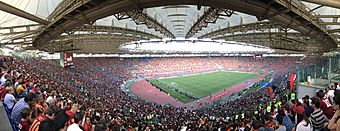 |
|
| Location | Viale dello Stadio Olimpico, Foro Italico, Rome, Italy |
|---|---|
| Owner | Italian National Olympic Committee |
| Operator | A.S. Roma and S.S. Lazio |
| Capacity | 70,643 seated |
| Construction | |
| Broke ground | 1927 |
| Opened | 1953 |
| Renovated | 1990 |
| Architect | Annibale Vitellozzi |
| Tenants | |
| A.S. Roma (1953–present), S.S. Lazio (1953–present) |
|
Roma's first stadium was the Motovelodromo Appio. They then moved to Campo Testaccio (1929–1940) and the Stadio Nazionale del PNF (1940–1953). Since 1953, Roma has played at the Stadio Olimpico, which they share with Lazio. The stadium was largely rebuilt for the 1990 FIFA World Cup. During this time, Roma played at Stadio Flaminio.
For many years, Roma planned to build a new stadium called Stadio della Roma. However, this plan was cancelled in 2021. Now, the club is planning a new stadium in Pietralata. Construction is expected to start between 2025 and 2026 and finish by 2028.
Stadiums Used by the Club
- 1927–1928 Motovelodromo Appio
- 1929–1940 Campo Testaccio
- 1940–1953 Stadio Nazionale del PNF
- 1953– Stadio Olimpico (1989–1990 Stadio Flaminio due to renovations on Olimpico)
Trigoria Training Centre
Roma's sports centre, called Trigoria, was bought in 1977 and opened in 1979. Its official name is the Fulvio Bernardini di Trigoria, named after club legend Fulvio Bernardini.
Since 2019, the Trigoria training ground also has a private school for the team's young players. It's called 'Liceo Scientifico Sportivo A.S. Roma'. This centre also hosted the Argentina national team during the 1990 FIFA World Cup.
Roma Supporters and Rivalries
Roma is one of the most popular football clubs in Italy. Many Roma fans come from the inner city of Rome, especially the Testaccio area.
The club's traditional fan group was Commando Ultrà Curva Sud (CUCS). This group was very famous in European football. Today, the Curva Sud section of the Stadio Olimpico is home to various fan groups.
The most famous club anthem is "Roma (non-si discute, si ama)", which means "Roma is not to be questioned, it is to be loved." It is sung before every match. Another song, "Grazie Roma," is played after home wins.
Major Rivalries
Roma has several strong rivalries. Their biggest rival is Lazio, the other major club in Rome. Their matches are called the Derby della Capitale, and they are known for being very intense. Sometimes, these matches have seen violence, which is very sad. For example, a Lazio fan died in 1979 after being hit by a flare.
Roma also has a rivalry with Napoli, called the Derby del Sole (Derby of the Sun). Other rivals include Juventus, Milan, Atalanta, and Internazionale, especially because these teams often compete for top spots in the league and a place in the UEFA Champions League.

Unfortunately, some rivalries have led to serious violence involving groups of fans known as ultras. There have been instances where Roma ultras have attacked supporters of other clubs, both Italian and foreign. These incidents are very serious and have resulted in injuries. Football should be about sport and fair play, not violence.
Players and Management
Current Squad
|
|
Primavera Squad (Youth Team)
|
|
Other Players Under Contract
|
|
Players Out on Loan
|
|
Women's Team
AS Roma also has a successful women's football team.
Famous Players in Roma's History
Some of Roma's most iconic players include Attilio Ferraris IV, the club’s first captain, and Amedeo Amadei, who is still the youngest Serie A goalscorer. In the 1950s and 1960s, stars like Giacomo Losi and Dino da Costa played for the club. The 1980s saw legends like Agostino Di Bartolomei, Bruno Conti, Roberto Pruzzo, and the Brazilian midfielder Falcão lead Roma to league and European success. Later, fan favorites included Rudi Völler, Aldair, Cafu, and Roman-born heroes Francesco Totti and Daniele De Rossi.
Retired Jersey Numbers
Since 2017, Roma has retired the number 10 jersey to honor Francesco Totti, who played for the club for 25 seasons.
|
Management Staff
| Position | Staff |
|---|---|
| Chairman | |
| Vice Chairman | |
| Chief Executive Officer | Vacant |
| Sporting Director | |
| Senior Advisor | |
| Director of Development | |
| Team Manager | |
| Academy Manager | |
| Loan Manager | |
| Head Coach | |
| Assistant Coach | Vacant |
| Goalkeeping Coach | |
| Technical Coach | |
| Athletic Coach | |
| Match Analyst | |
| Performance Manager | |
| Head of Scouting | |
| Scout | |
| Chief Analyst | |
| Chief Medical Officer | |
| Head of Medicine | |
| Physiotherapist | |
| Sports Scientist | |
| Podiatrist | |
| Osteopath | |
| Nutrionist | |
| Secretary | |
| Referee Caretaker |
Last updated: 17 June 2025.
Source:
Club Leaders: Chairmen History
Roma has had many chairmen throughout its history. Some were owners, and others were chosen by the owners. Franco Sensi was chairman until 2008, and his daughter, Rosella Sensi, took his place. Here is a list of Roma's chairmen from 1927 until today.
|
|
Coaches Through the Years
Roma has had many managers and coaches throughout its history. Here is a list of them from 1927 onwards.
|
|
|
Club Achievements and Trophies
National Titles
- Serie A (Italian League):
- Winners (3): 1941–42, 1982–83, 2000–01
- Runners-up: (14): 1930–31, 1935–36, 1980–81, 1983–84, 1985–86, 2001–02, 2003–04, 2005–06, 2006–07, 2007–08, 2009–10, 2013–14, 2014–15, 2016–17
- Coppa Italia (Italian Cup):
- Winners (9): 1963–64, 1968–69, 1979–80, 1980–81, 1983–84, 1985–86, 1990–91, 2006–07, 2007–08
- Runners-up: (8): 1936–37, 1940–41, 1992–93, 2002–03, 2004–05, 2005–06, 2009–10, 2012–13
- Supercoppa Italiana (Italian Super Cup):
- Winners (2): 2001, 2007
European Titles
- European Cup:
- Runners-up (1): 1983–84
- UEFA Cup / UEFA Europa League:
- Runners-up (2): 1990–91, 2022–23
- UEFA Conference League:
- Winners (1): 2021–22
- Inter-Cities Fairs Cup:
- Winners (1): 1960–61
Other Titles
- Serie B:
- Winners (1): 1951–52
- Anglo-Italian Cup:
- Winners (1): 1972
Hall of Fame: Honoring Club Legends
On October 7, 2012, the AS Roma Hall of Fame was created. Players are chosen by votes from the club's official website and a special panel.
|
Added in 2012:
|
Added in 2013:
|
Added in 2014:
|
Added in 2015:
|
|
Added in 2016:
|
Added in 2017:
|
Added in 2018: |
Club Records and Statistics
Francesco Totti holds the record for most appearances for Roma, playing 786 games in all competitions from 1993 to 2017. He also has the most Serie A appearances with 619 games.
Totti is also Roma's all-time leading goalscorer with 307 goals, including 250 in Serie A. Roberto Pruzzo is second with 138 goals. In 1930–31, Rodolfo Volk scored 29 goals in a single Serie A season, a record later matched by Edin Džeko in 2016–17.
Roma's first official match was a 2–0 win against Livorno in 1927–28. Their biggest victory was 9–0 against Cremonese in 1929–30. Roma's heaviest defeat is 1–7, which has happened five times.
Divisional Movements
| Series | Years | Last | Promotions | Relegations |
|---|---|---|---|---|
| A | 92 | 2024–25 | 45 times to Europe | |
| B | 1 | 1951–52 | never | |
| 93 years of professional football in Italy since 1929 | ||||
| AS Roma created in National Division in 1927 | ||||
UEFA Club Ranking
Roma is ranked among the top football clubs in Europe by UEFA.
| Rank | Club | Points |
|---|---|---|
| 8 | 84.750 | |
| 9 | 83.250 | |
| 10 | 80.500 | |
| 11 | 77.750 | |
| 12 | 77.500 |
UEFA Rankings Since 2005
| Season | Ranking | Movement | Points | Change |
|---|---|---|---|---|
| 2024–25 | 10 | 80.400 | ||
| 2023–24 | 6 | 101.000 | ||
| 2022–23 | 10 | 97.000 | ||
| 2021–22 | 11 | 100.000 | ||
| 2020–21 | 13 | 90.000 | ||
| 2019–20 | 17 | 80.000 | ||
| 2018–19 | 14 | 81.000 | ||
| 2017–18 | 21 | 64.000 | ||
| 2016–17 | 37 | 39.000 | ||
| 2015–16 | 51 | 27.500 | ||
| 2014–15 | 46 | 49.500 | ||
| 2013–14 | 55 | 26.500 | ||
| 2012–13 | 43 | 40.500 | ||
| 2011–12 | 26 | 57.500 | ||
| 2010–11 | 16 | 73.000 | ||
| 2009–10 | 14 | 0 | 71.000 | |
| 2008–09 | 14 | 66.000 | ||
| 2007–08 | 16 | 0 | 62.000 | |
| 2006–07 | 16 | 57.000 | ||
| 2005–06 | 17 | 54.000 |
Football Club Elo Rating
| Rank | Club | Points |
|---|---|---|
| 17 | 1820 | |
| 18 | 1815 | |
| 19 | 1807 | |
| 20 | 1807 | |
| 21 | 1803 |
Images for kids
-
Francesco Totti, Roma's top goalscorer and player with the most appearances.
See also
 In Spanish: Associazione Sportiva Roma para niños
In Spanish: Associazione Sportiva Roma para niños


